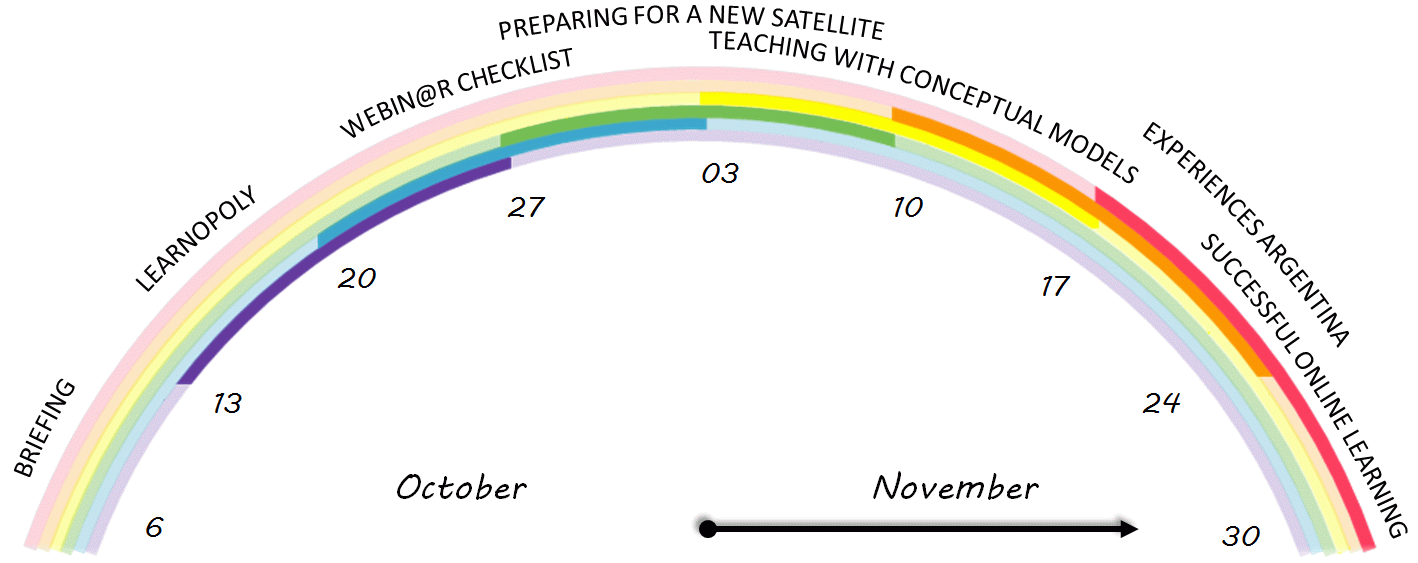CALMet Online 2014
Perfilado de sección
-
CALMet Online is now closed, but the website will remain open for enrollment and browsing the content.
All resources and discussion forums are still available
Welcome to participate CALMet Online 2014!
This web site will be our area for discussion and sharing resources.
You can take a look into the session descriptions on the main page.
Click at the Session Title to see all the currently available session content. You can return to overview by clicking at the rainbow.
-
 This session will open the CALMet Online 2014.
This session will open the CALMet Online 2014.Sarah Kimani (IMTR, Kenya).
In this session we are going to have various African meteorologists who will be discussing the current weather and other interesting weather phenomena that may be taking place over Africa during the week.
The purpose of this session is to interact with each other using weather and meteorological issues, and to introduce this mode of learning and training as a tool for training and holding very low bandwidth webinars.
We invite all the CALMeters to participate by either posting interesting images during the week and joining the live briefings on 6 October at 08 UTC and 8 October at 12 UTC to accommodate different time zones. In the times between the briefing area will remain open for any discussion or contribution.
Actividades: 10 -
Patrick Parrish (WMO) and Maja Kuna (EUMETSAT).
 In this game-base workshop, teams of players will compete to create ideas for learning activities for training a variety of meteorology skills. The team with the most activities submitted and the team with the highest-rated activity overall will win the competition.
In this game-base workshop, teams of players will compete to create ideas for learning activities for training a variety of meteorology skills. The team with the most activities submitted and the team with the highest-rated activity overall will win the competition.Teams will first choose 3 topics to work with from a list provided. They then spin the "Wheel of Learning Solutions" to decide the format for the training (Classroom, Online Synchronous, or Online Asynchronous). Finally, they will work together come up with ideas for using up to 7 (or more) types of learning activities. Each of the learning activities represents a useful tactic to engage students in applying what they learn, or in thinking deeply about what they are learning.
Learnopoly players should expect to commit up to 2-3 hours during the week of 13 October contributing to their team's effort. Are you up to the challenge? We think you are. And we think you will have fun playing while you learn about the fun and challenge of designing active learning approaches.
Language-based teams are welcome! Just let us know. Español, français, Indonesian... you will need at least 4-5 people on your team, and must submit your final activities in English so everyone can read them.
Actividades: 11 -
Maja Kuna (EUMETSAT), Luciane Veeck (VLab), Anna Ghelli (ECMWF), Ivan Smiljanic (EUMeTrain), Alessandro Chiariello (EUMETCAL).
Mike had been working in a training division for a couple of years. He had just started updating his slides for the next edition of the course he delivers every year in spring, when Andy, his manager, dropped in to his office and said:"The conference was just great! So many fantastic presentations. You should have seen how folks overseas organize training events. Why don't we also schedule a series of webinars this year?"
Could you easily put yourself in Mike's shoes? Have your manager come to you already with a similar question? Maybe you are a manager tempted to try online solution? Many of us participated or at least heard about webinars, online weather briefings or online event weeks. Where would you start when planning a real-time online activity? You think, fine, I need a presenter and a tool! Is that all you should think of? In this session we will try to collect all the items for the webinar preparatory and post event checklist. This list will help everyone to remember important steps in the process like...the audience. Yes! We need a presenter, a tool, an audience and...Let's explore and map the other pieces in the Webin@r Checklist session.
Actividades: 25 -
Bernadette Connell (CIRA)

Imagine this conversation: “It is exciting to be preparing for a new satellite! Where do we start? Basics. What’s similar? What’s new? What’s different? How will this affect us? Wow! There will be a 16 channel imager, a geostationary lightning sensor and more frequent imagery. What’s that you say? The data format will be different? Hmmm. Do you have any inexpensive software suggestions? How will we get the data? Our internet connection barely keeps up with what we receive now. No, we can’t afford one of those satellite direct readout stations….”
Well, maybe you didn’t need to imagine it –If you are like me, you have heard many similar conversations with many more questions. Deciding where to start and what information to present reflects your own experiences. How did you learn? How do others learn? It depends on their learning style and their level of experience. During the first week of this session we will look at basic types of information available for GOES-R and participants will help classify who the information should be directed towards (forecaster: intern, experienced, expert ) and why. We will also encourage participants to offer suggestions on how to modify the content for their region or another type of user. During the second week, we will focus on aspects of data access and visualization to create a product example in preparation for the new satellite. As a participant you can either create your own example or collaborate with and use the talents of other participants to create a basic example for your chosen intended audience (intern, experienced, expert).
We won’t get around to addressing all the questions of the first paragraph, but we’ll likely experience many of them.
Actividades: 14 -
Marianne Weingroff (COMET) and Bruce Muller (COMET).
The use of conceptual models enhances our understanding of the physical world. In the fields of atmospheric science and hydrology, students learn to define the world with equations representing physical parameters and processes. Bringing them to life via visualizations and 3-dimensional conceptual models can lead to a better understanding of the dynamics of the atmosphere and thus better forecasts. In this session, we'll discuss the use of conceptual models in teaching, develop a list of conceptual model resources, and identify conceptual model resources that need to be developed to support our collective training needs.
Actividades: 7 -
Experience Zonda: An example of A Conceptual Model Applied on A Simulator - Experiencia Zonda: Ejemplo de Modelos Conceptuales Aplicando Simuladores. Graciela Rolón (Servicio Meteorológico Nacional - Argentina).
Experience in Distance Learning in Meteorology - Experiencia en Educación a Distancia en Meteorología. Moira Doyle, Elizabeth Castañeda, Leonor Bonan, Lorena Gonzalez
and Ana Pittaro (Department of Atmospheric and Oceanic Sciences of the University of Buenos Aires).Actividades: 45 -

This session will end the CALMet Online 2014.
Roger Deslandes and Bodo Zeschke (Bureau of Meteorology, Australia).
A key challenge in delivering successful on-line learning and development activities is to employ strategies that promote learner engagement through interactions. Although constructivist learning and interactivity are well-established in a pedagogical sense, creating such environments in the virtual world can be challenging.
During this CALmet session useful strategies will be articulated by way of two case studies that the Bureau of Meteorology Training Centre have recently engaged in: The EumetCAL radar course, conducted in 2013, was delivered as a blended course consisting of several online presentations and a face to face five day workshop conducted at the Deutscher Wetterdienst in Langen, Germany. The first case study will focus on a half-day session delivered online into the workshop at Langen; As a Centre of Excellence in the WMO-CGMS Virtual Laboratory for Education and Training in Satellite Meteorology BMTC conduct monthly Regional Focus Group online weather discussions and training sessions to a cohort of international stakeholders. The second case study will overview techniques utilised in this forum to engage stakeholders.
The key objective of this session is that participants will be able to utilise these and similar strategies to enhance their own training events.
Actividades: 17


